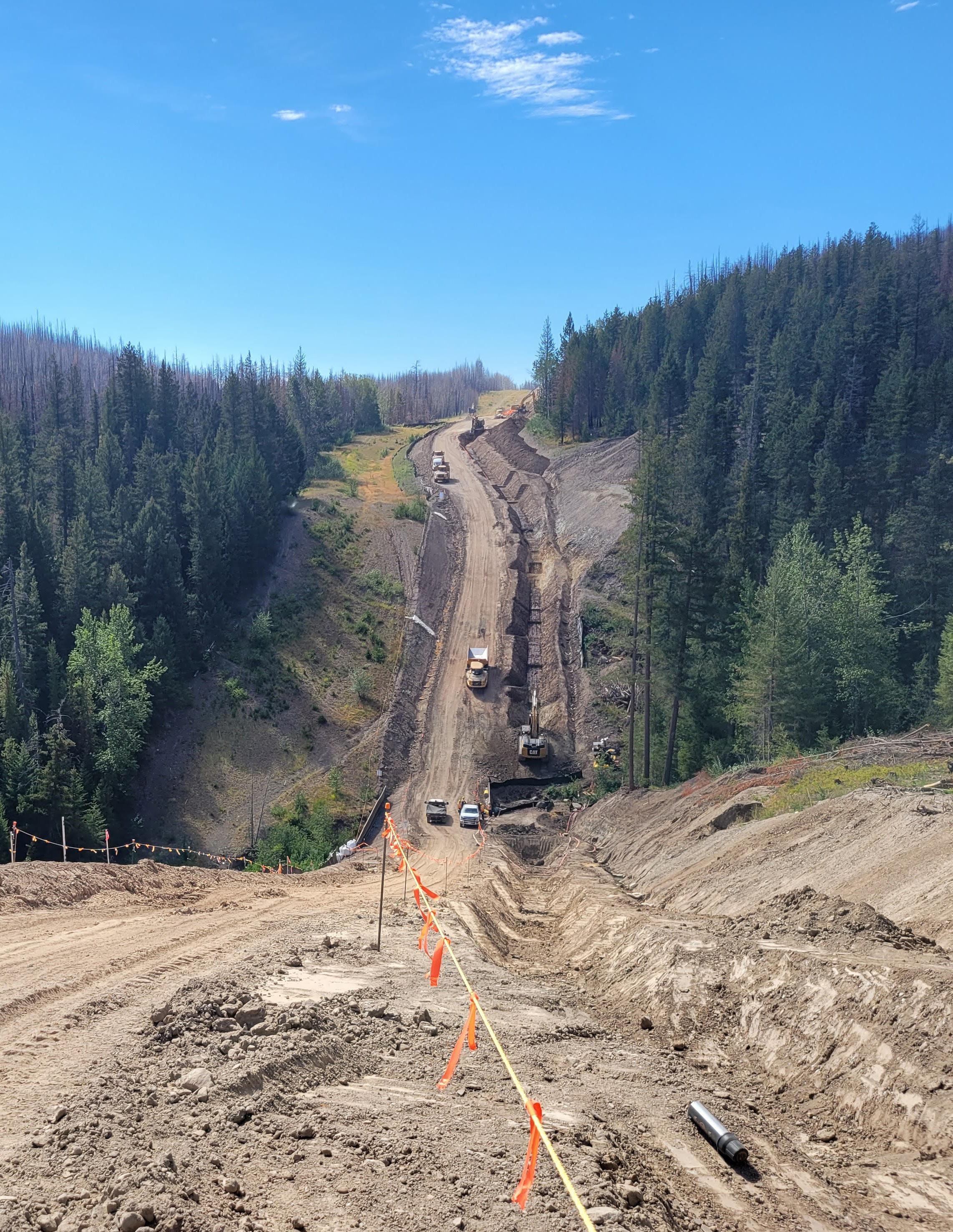








At BGC, we have always valued innovation as a key part of who we are and what we do. Innovation is ingrained in our core values and is evident in the technical services we offer to our clients and partners. It is essential for our ability to deliver practical solutions and environmental stewardship in resource, transportation, and land development projects across all types of geophysical environments.
We love finding new ways to solve hard problems, grow our knowledge, and apply our expertise to make a better world for the industries and communities we work with. Since 2014, BGC has invested over $32M on 249 projects. These projects have helped BGC staff, graduate students, postdoctoral students, and industry-academic teams across different fields.
Our investments in innovation broadly fit into three categories:
01 Horizon 1 (~60% of projects):
Projects that aim to enhance or develop a current method. These projects increase our skills and work quality. They are often used in client projects right away.
02 Horizon 2 (~25% of projects):
Projects that experiment with new technologies, methods, or algorithms under realistic conditions. These projects build on existing knowledge and enhance our abilities. They are often done in partnership with academic institutions.
BGC’s investments in innovation have yielded outcomes across all the business sectors and technical fields we work in. They include: a patent for processing lidar change detection, the creation of flood frequency modelling that considers climate change impacts, riverbed stabilization using natural solutions, and improved techniques for lab testing and modelling of static liquefaction.
We invest in our people through innovation with equitable access and support to all staff. We are proud to report that 51% of our funded R&D projects in 2023 were led by women, accounting for 46% of the total expenditure.
We are thankful for the dedication to innovation and contribution of all BGC staff.
Matt Lato , Ph.D. Eng., P.Eng. Quality & Innovation LeadSince 2023, BGC has supported over 100 projects , including 20 initiatives connected to 12 universities in North America, Australia, and Europe.
03 Horizon 3 (~15% of projects):
Projects that create new ideas, methods, or hypotheses. These projects can result in significant advances in their fields if they work. Horizon 3 projects allow for more exploration and higher risks.
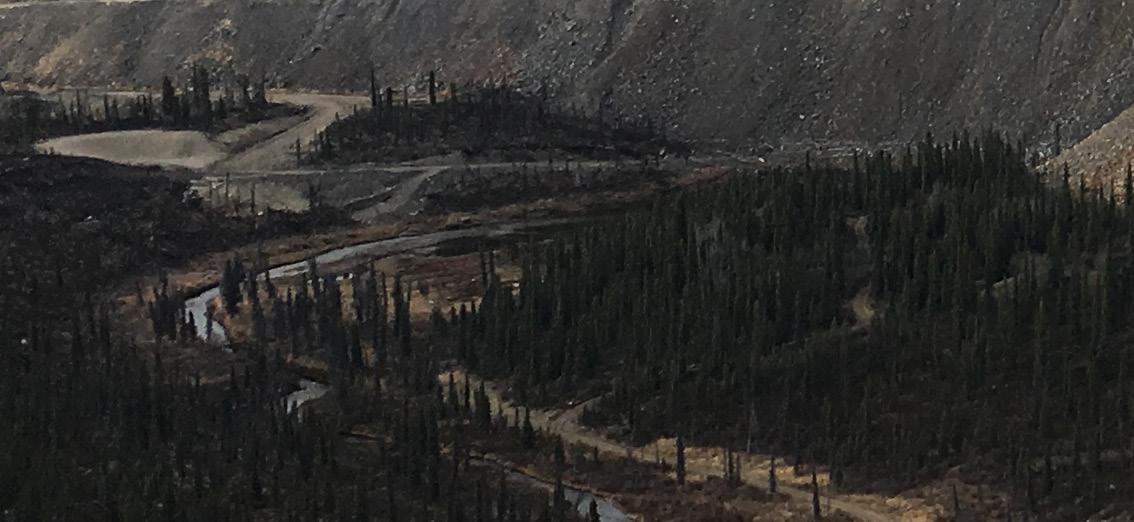
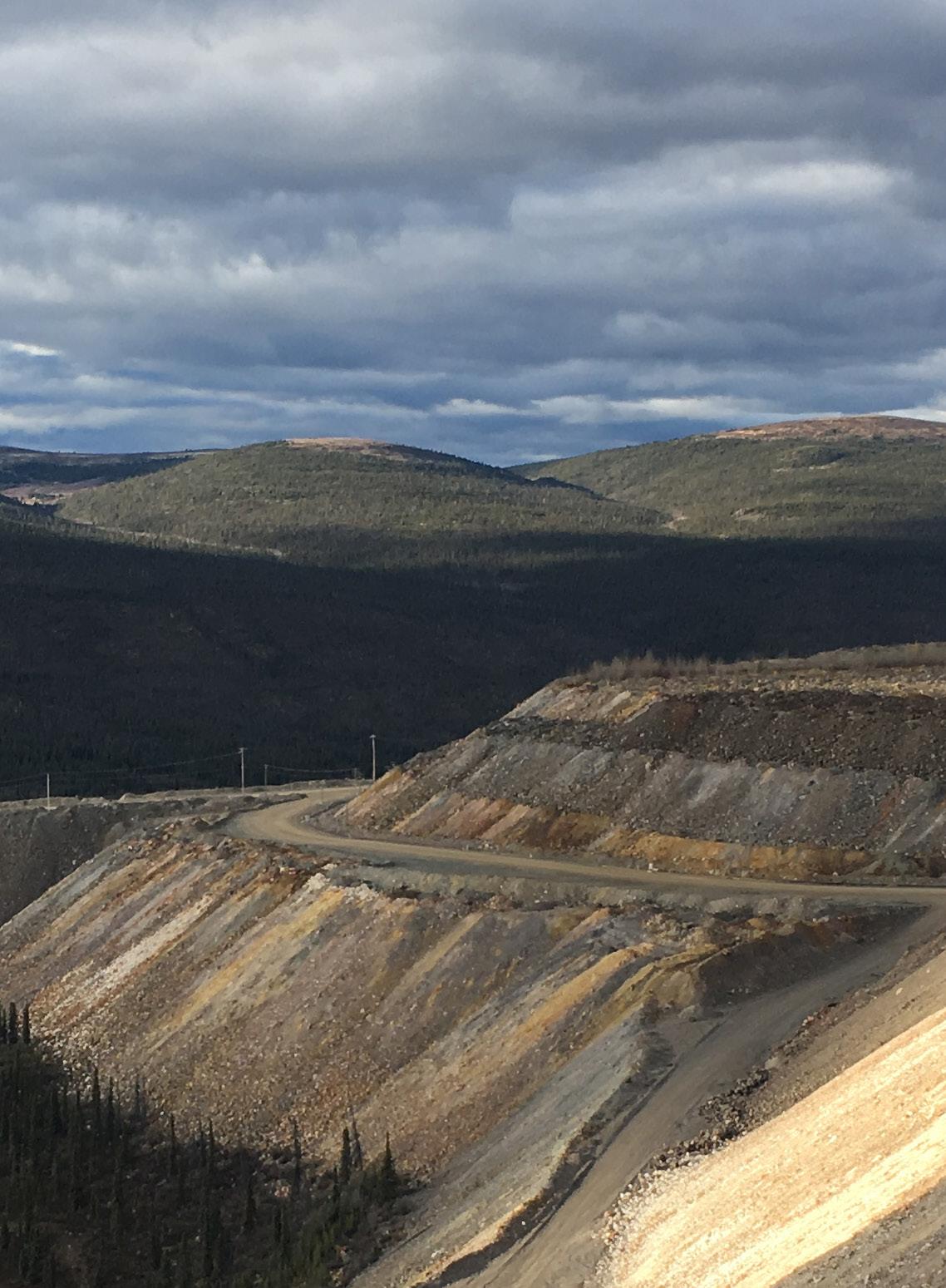
In 2023, BGC staff published 24 papers in peer-reviewed journals, 78 conference papers and presentations, and authored 1 book chapter.
In 2023, 290 BGC staff participated in 83 different R&D projects.

Cambio is a cloud-based earth science platform that empowers organizations to make better, proactive, and risk-informed decisions for their critical infrastructure.

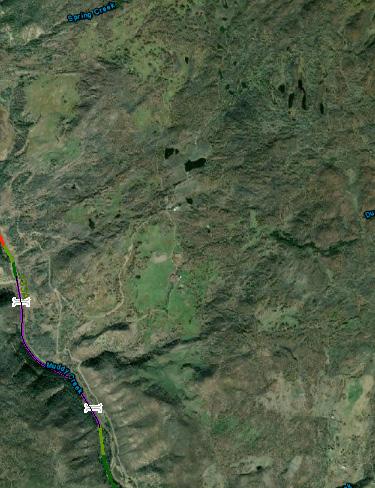
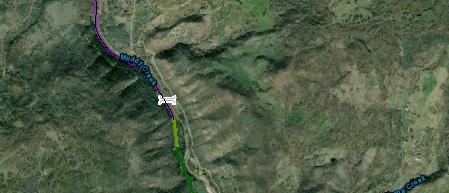

BGC has invested over $20M in the Cambio software platform in the past seven years. Through that investment, Cambio has grown from a platform focused on geohazard and geo-asset management for pipeline operators, to a platform used by over 100 organizations across the railway, highway, mining, communities, and energy sectors for risk-informed decision making. To support the continued growth and evolution of Cambio as a commercial, enterprise software offering, BGC launched a wholly owned subsidiary, Cambio Earth Systems Inc., in January 2024.
Cambio is a powerful yet intuitive software platform that enables a systematic approach to managing complex earth science challenges impacting critical infrastructure. Built on BGC’s multi-decade experience in geohazards, the platform is designed to power geohazard risk management programs and improved infrastructure management decision making, leading to better allocation of resources and more cost-effective and defensible solutions.
At the heart of the platform is the ability to integrate a wide variety of public and operational data sources in context with critical infrastructure; making it easier to assess and prioritize geohazard and geo-asset risk and to deliver actionable insights. By combining geospatial data sets, earth observation data, asset mapping, inspection information, climate histories and forecasts, photo records and other critical information – along with a variety of predictive algorithms and analytical tools – Cambio enables operators to perform standardized risk assessments and deploy industry-leading management processes.
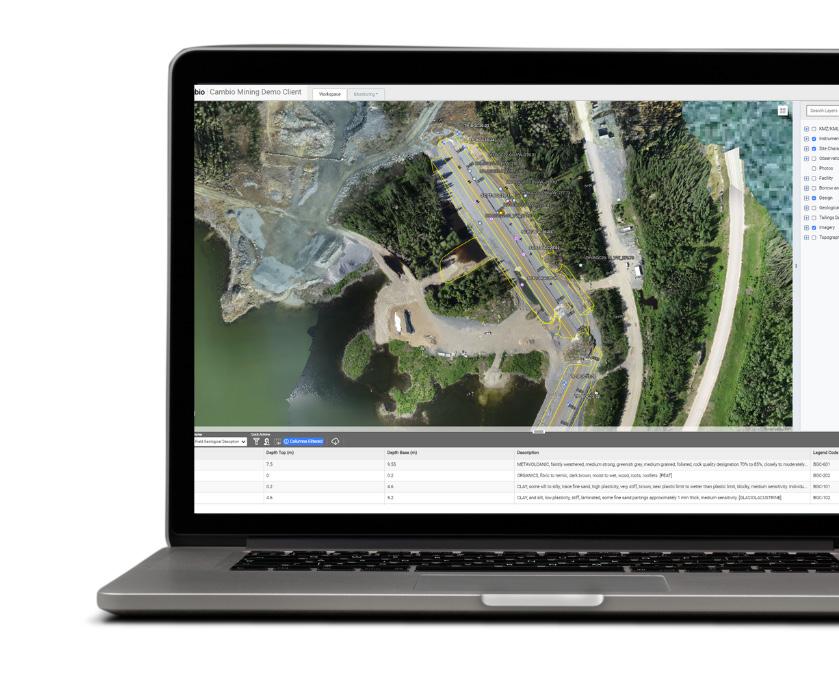
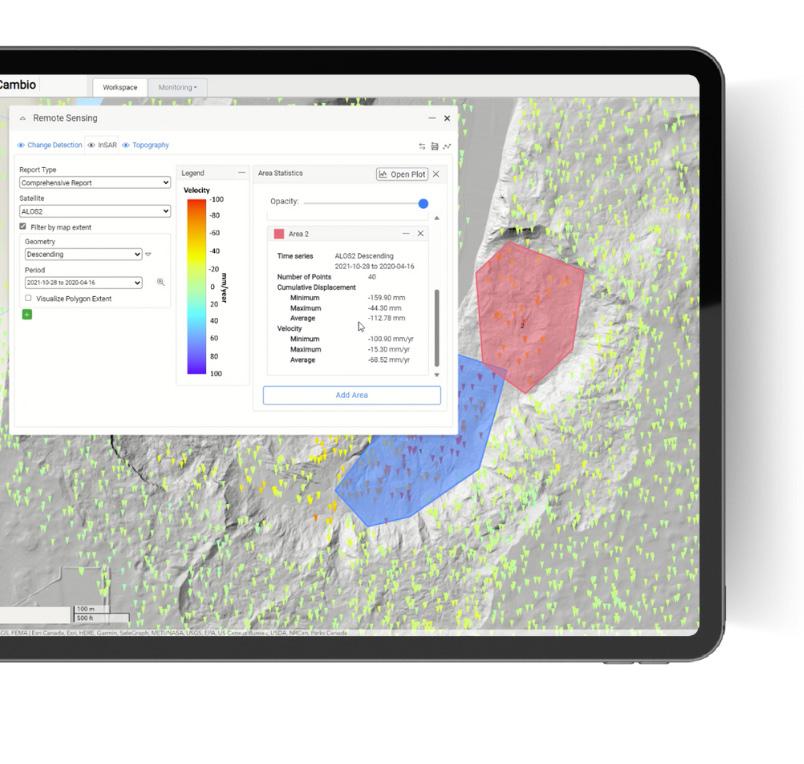
Cambio also provides operational tools such as real-time flood, precipitation, and earthquake alerting for high risk sites as well as field inspection workflows – using the Cambio mobile application – to digitally transform monitoring programs. When integrated with program management and action tracking features, organizations can make the right decisions, at the right time, to optimize resource allocation.
BGC and the community of Cambio users are constantly working together to innovate and improve the platform and, through that effort, advance industry best practices for geohazard and geo-asset management.

In 2023, over 290 BGC personnel worked on 83 different internal R&D projects. Internal R&D projects are managed and executed by BGC staff and typically involve multi-disciplinary teams to bring ideas to fruition. These collaborative projects involve partnerships with clients, academics, industry, and policy makers. Together, we direct our efforts toward solving real-world problems.
The 2023 projects cover every discipline we work in, from geohazard identification and warning to lab testing, numerical modelling of tailings dam performance, and dam breach runout modelling. We are excited to work with universities around the world from the University of Fribourg, Switzerland to the University of Western Australia. These projects have produced new lab equipment, risk assessment algorithms, and software platforms.
The path one takes from idea to innovation is rarely straight. R&D projects at BGC reflect that. Our projects range from collaborating with university professors on open-ended blue-sky research questions, such as how to use bacteria to solidify tailings, to leveraging advanced statistical analyses to improve forecasting of flood flows. These initiatives help advance the state of applied earth science practice, develop new or more efficient methods, reduce uncertainty, and improve the quality and communication of our work.
Over the past year, we have continued to harness machine learning, and data science capabilities to solve complex applied earth science problems. Machine learning applications include:
Predicting discharges in rivers using data-driven models
Estimating channel dimensions and potential channel scour based on watershed characteristics
Automated anomaly detection for real-time streamflow gauges across North America
Automatically mapping landslides from digital terrain models
Three of our major R&D projects – mapping of wildfire severity, advanced soil mechanics testing, and stabilization of mine tailings through biocementation – are showcased along with a list of project highlights.
Lauren Hutchinson , M.A.Sc., P.Eng. Research & Development Lead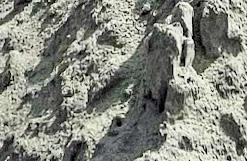
Over 290 staff worked on 83 projects

Over the last few years, increasingly severe and frequent wildfires have led to an increase in the occurrence of post-fire debris flows. These events are typically triggered with intense rainfall on recently burned slopes and are more likely where slopes were burned at a high intensity. BGC is developing world leading post-fire debris flow assessment and management techniques. Our work helps evaluate where these debris flows are most likely to occur after a wildfire.
A critical dataset for the workflow is a map of vegetation burn severity, which shows the relative intensity of the fire across the burn scar. Burn severity can be assessed using publicly available multispectral satellite imagery. Historically, burn severity maps were provided by federal agencies (e.g., B.C. Wildfire Service, U.S. Forest Service). Unfortunately, this process can take months, and for some fires, these agencies may never produce burn severity maps. In one recent instance, post-fire debris flows occurred before the burn severity maps were issued! Clearly, a faster solution is needed.
Over 2022 and 2023, BGC developed semi-automated workflows using Python and Google Earth Engine to produce burn severity maps. We can now monitor new satellite imagery (typically acquired ~weekly) and produce updated maps in minutes. BGC’s process includes filters for clouds, snow, or water. This step is necessary as single images don’t always cover the entire burn scar or can be significantly affected by clouds or smoke. Our methods are built to take many images and produce the clearest possible composite image for processing.
Our team continues to invest in the development of rapid, scalable tools to estimate post-fire debris flow likelihood and magnitude that support critical decisions on public safety and asset management.

Carie-Ann Lau , M.Sc., P.Geo.
Corey Sheip , Ph.D., P.G.
Hazel Wong , M.Eng., P.Geo.
Joe Gartner , Ph.D., P.E., P.Eng.
Kevin McCoy , Ph.D., P.G. BGC Team
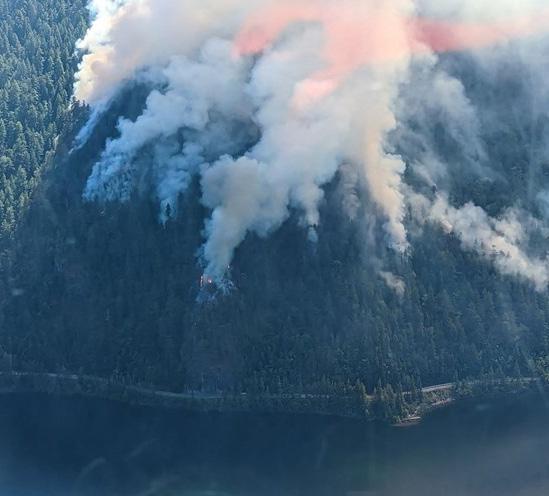
Flow liquefaction in the foundation and construction materials of tailings dams has seen an increased level of focus following the recent failures of the Fundão (2015), Cadia (2017), and Feijão (2019) tailings dams. Flow liquefaction is a geotechnical phenomenon which can occur under certain conditions in cohesionless soils, such as sands and silts. It is characterized by a sudden loss of strength in the soil, causing the soil to behave like a liquid rather than a solid which presents numerous geotechnical challenges.
Defining the Critical State Line (CSL) of dam foundation material is crucial to assess a material’s susceptibility to flow liquefaction. The in-situ density of a given material is compared to the CSL and indicates its liquefaction potential. If the material is denser than CSL, it is dilative, if the material is looser than the CSL, it is contractive and more likely to liquefy.
As a best practice, laboratory tests called triaxial tests are used to define the CSL. The triaxial tests are often completed on loosely compacted reconstituted specimens with height-to-diameter (H:D) aspect ratios of approximately 2:1, in accordance with the American Society for Testing and Materials (ASTM) standards. However, when performing triaxial tests on densely compacted specimens with a 2:1 H:D aspect ratio there are routinely challenges related to strain localization or shear banding of the dense specimens. Shear banding is undesirable because it reduces the shearing to a localized area, meaning only the material in the localized area is dilating or contracting, which does not provide a clear understanding of how the entire sample will behave under stress.
The effects of changing the sample aspect ratio have not been studied as part of the current standard ASTM practice for CSL testing. However, literature findings suggest that using specimens with a 1:1 H:D aspect ratio (with lubricated free ends to allow the sample to dilate radially) increases sample uniformity (Rowe and Barden, 1964). In addition, the use of specimens with a 1:1 H:D aspect ratio has not yet entered into commercial practice because this method of testing has yet to be proven to be as effective as using 2:1 H:D specimens for defining the CSL.
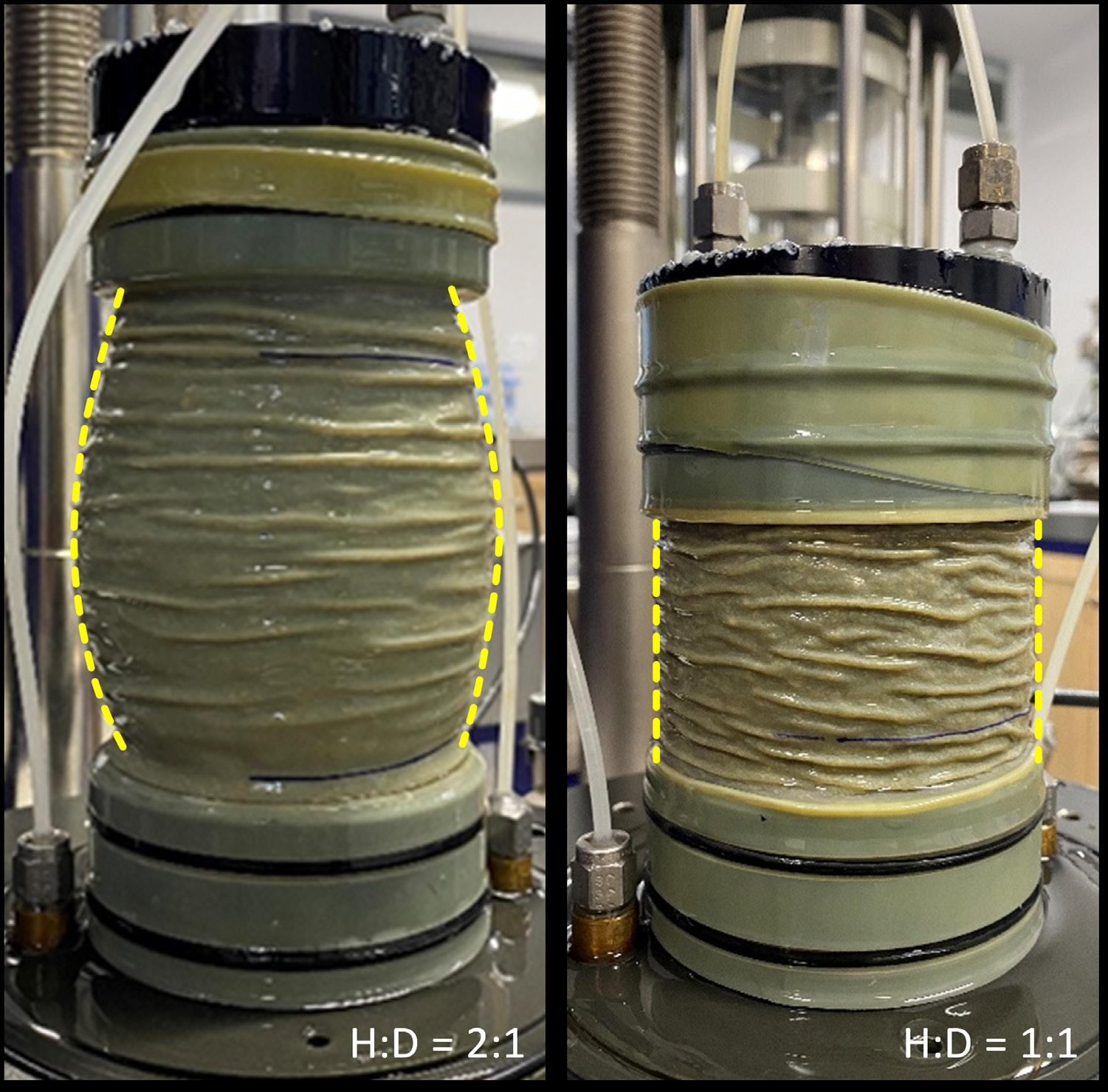


To investigate the effect of the aspect ratio on the determination of the CSL of sand, BGC completed a laboratory testing program that involved a suite of drained and undrained triaxial compression tests on specimens with 2:1 and 1:1 H:D aspect ratios. The material tested consisted of a clean, fine to coarse, quartz and feldspathic sand quarried from a natural deposit of glaciofluvial material on the outskirts of Fredericton, NB. BGC completed triaxial compression tests on twelve, 2:1 and sixteen, 1:1 H:D ratio specimens. All testing was completed using lubrication between the top and bottom caps, oversized end platens, and post-testing sample freezing as per industry and BGC’s standard practices.
BGC developed CSLs for the 2:1 and 1:1 H:D aspect ratio samples and determined:
The two CSLs were virtually identical. Specimens with the 1:1 H:D ratio deformed more uniformly than those with the 2:1 H:D ratio and consistently reached the CSL, even when dense of the critical state.
This program demonstrated that using 1:1 H:D specimens is appropriate to determine the CSL and exhibits uniform deformation and delayed formation of localized shear deformation (shear banding).
One of the principal benefits of testing specimens with H:D ratios of 1:1 over the more conventional 2:1 is that the CSL may be defined by testing either dense or loose, drained or undrained samples. In fact, when testing dense sand samples the use of specimens with a 1:1 H:D ratio is preferred, to improve the consistency of results to define the CSL.
The results of the testing program have the potential to change the industry standard for determining the CSL by reducing specimen preparation time and improving accuracy.
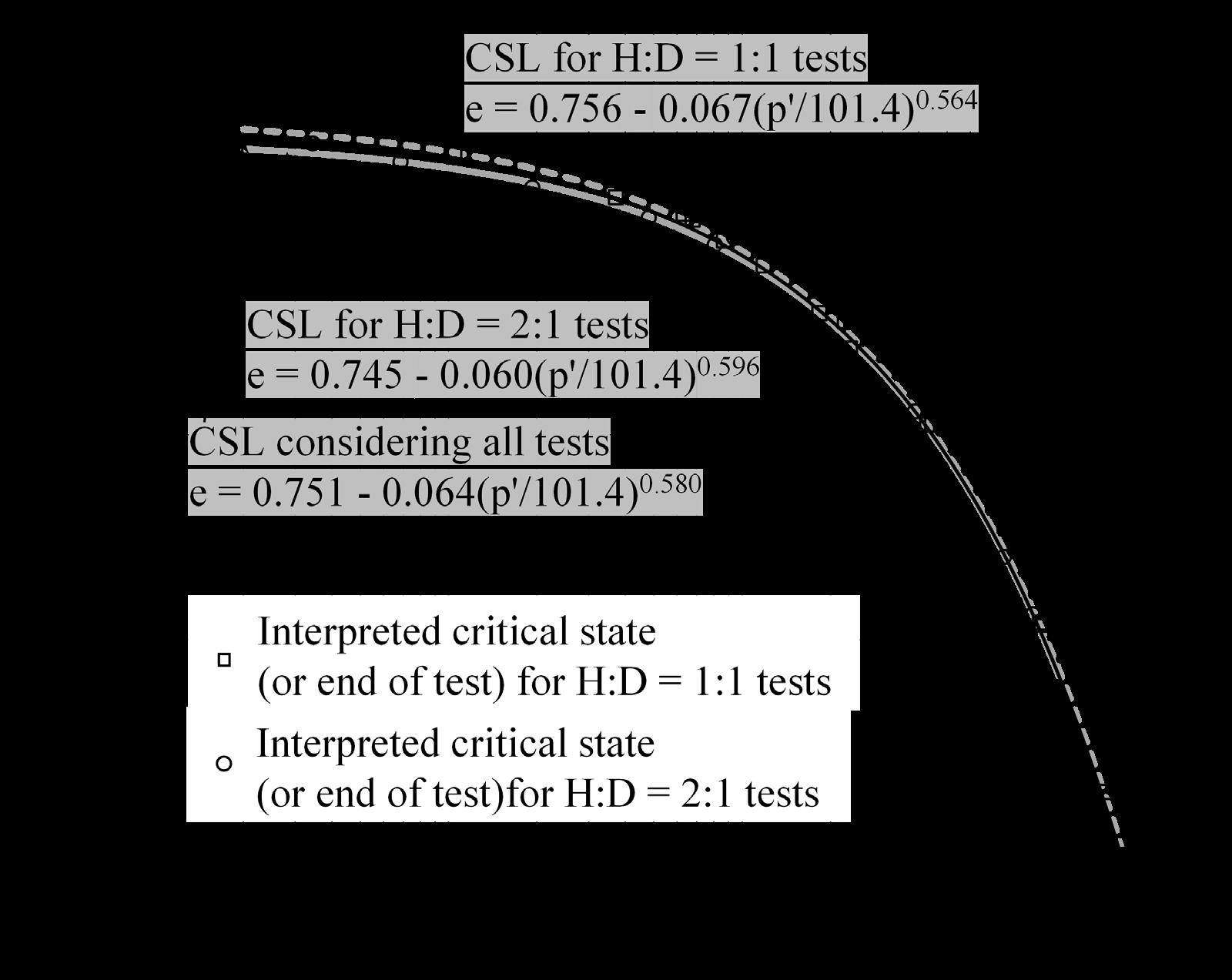
Adrian Wightman , M.A.Sc., P.Eng., F.EIC.
Chang-Gyun Jeong , M.Sc., EIT
Mike Billings , B.Sc.E., P.Eng.
Simon Dickenson , Ph.D., P.Eng.
Thava Shanmugarajah , M.A.Sc., P.Eng.
Mine tailings are a byproduct of mining created during the ore extraction and milling process and are typically comprised of fine sands and silts. Mine tailings stabilization is a significant challenge for the mining industry due to the safety and environmental risks associated with poor tailings mechanical strength. Traditional mechanical stabilization methods, such as physical containment behind dams and dusting controls, have limitations in terms of effectiveness, long-term durability, and cost.
In this study, BGC worked with the University of British Columbia (UBC) and Hudbay Minerals Inc. to demonstrate a nature-based biocementation approach at a bench scale to improve the mechanical strength of mine tailings. The approach used microbialinduced carbonate precipitation (MICP) to produce calcium carbonate (CaCO3), which acts as a binding material between the tailing particles to form a cement-like matrix, thereby increasing the mechanical strength of the tailings.
In this work, native ureolytic bacteria (bacteria with a urea hydrolysis metabolic pathway) were enriched and isolated from six different types of tailings. The results showed that the native bacteria and the model organism could cement the mine tailings samples. By using native bacteria, implementation of this biotechnology has a greater chance of success in the field, as those bacteria are already present in the tailings and capable of surviving the in-situ conditions when bio-stimulation strategies are applied. These results indicate a promising potential for using biocementation technology for tailings stabilization at a commercial scale. Such advances could have larger implications on the overall safety of existing tailings dams.
Syringe results
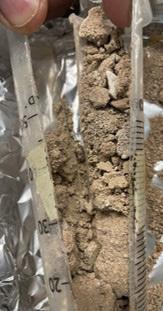
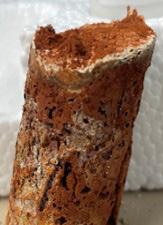
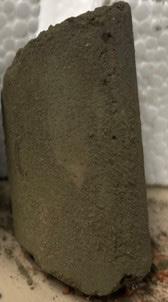
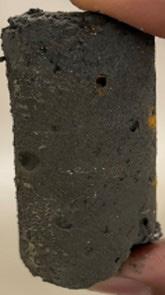
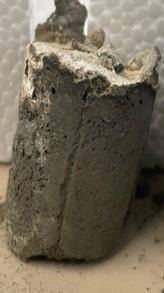
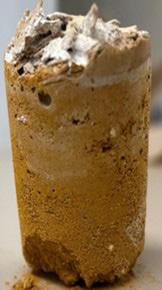
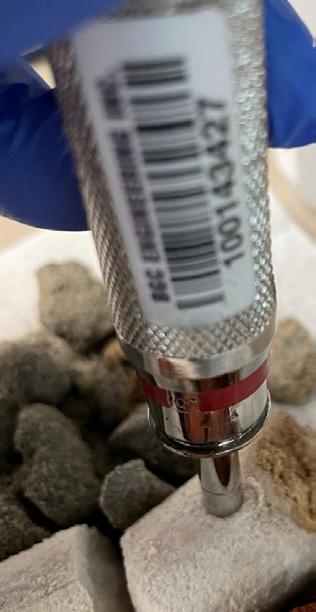
(*)
Biocemented sample with qualitative unconfined compressive strength (UCS) Testing using a pocket penetrometer.
Recent work has also identified the presence of native bacteria in all six tailings samples that are capable of producing cementation using the carbonic anhydrase metabolic pathway. It potentially allows for the capture and storage of carbon dioxide. BGC plans to work with our partners to explore this pathway and the potential for carbon capture and storage through 2024.
Bill Burton , M.Eng., P.Eng.
Horizon 3 Lead
Bill Burton , M.Eng., P.Eng.
Julian McGreevy , B.A.Sc., P.Eng., GIT
MD Al Imran , Ph.D. (UBC)
Sean Dean , M.Sc., P.Eng.
Sue Baldwin , Ph.D. (UBC)
Principal investigators: Hamish Weatherly, M.Sc., P.Geo.; Patrick Grover, Ph.D. P.Eng.; Rob Millar, Ph.D, P.Eng., P.Geo.; Saeid Ahadi, Ph.D., EIT; Prof. Ana Maria Ferreira da Silva, Ph.D., P.Eng. (Queen’s University)
Description: Development of physical and numerical modelling tools to assess scour beneath circular pipelines in rivers. This research developed more robust procedures and tools to assess the vulnerability of vortex-induced vibration (VIV) failure of pipelines at river crossings.
Principal investigators: Bill Burton, M.Eng.,P.Eng.; Brent Mooder, M.Sc., P.Eng.; Alexander (Sasha) Holden, Ph.D., P.Eng.; Kate Robey, M.Sc.; Paul Bauman B.Sc.E., P.Eng., M.Sc., P.Geoph.
Description: CO2 Lock Corp. is pursuing the development of a commercial process for mineralizing carbon dioxide for longterm storage using brucite-rich serpentinized peridotite at a site in British Columbia. In fall 2023, BGC completed surface geophysics surveying and a single borehole drilling program to improve understanding of site geology and hydrogeology, as well as a ‘proof-of-concept’ field trial to advance understanding of the potential for in-situ carbonated water injection into ultramafic bedrock at the site.
Principal investigators: Kathryn Franklin, MEERL, P.Eng.
Description: Guidance to produce climate change assessments with three levels of effort corresponding to a general level of understanding in which there is low risk to life or property; quantification of relevant changes to address projects that may carry a moderate risk to life or property if they fail; and derivation of specific data for detailed design input where the potential loss of life and/or property due to climate-related failure is substantial.
Principal investigators: Melissa Hairabedian, M.Sc., P.Geo.; Vincenzo Coia, Ph.D.
Description: Demonstrating the bias reduction of flood frequencies and magnitudes for watersheds driven by rainfall and snowmelt by incorporating these two processes in the model.
Principal investigators: Joel Van Hove, M.Eng., P.Eng., Michael Porter, M.Eng., P.Eng., Owen Bunce, B.ASc. EIT; Vincenzo Coia, Ph.D.
Description: Development of numerical modelling tools to analyse expected landslide velocities and displacements, based on known landslide characteristics and measured annual velocity to inform risk-informed decision making for linear infrastructure.
Principal investigators: Ian Stilwell, P.Eng., Kaushik Yanamandra, M.Eng. EIT; Shawn Hegger, M.A.Sc. EIT
Description: Direct shear testing remains the most effective method of determining the shear strength of natural discontinuities in rock. This project proposes new theories and challenges traditional approaches to analyzing the testing data. An example direct shear test is carried out at five increasing normal loads, the first of which is carried out at the lightest load detectable. The results demonstrate that damage to asperities on the joint surface facilitates shearing of the sample at a lower energy state, compared to when no damage is incurred. This challenges previous theories that suggest that asperity damage contributes to a component of shear strength.
Principal investigators: Lukas Arenson, P.Eng., Dr.Sc.Techn.ETH
Description: The goal of this project is to provide cuttingedge, nature-based solutions to not only enhance the stability of degrading permafrost to support northern infrastructure and geohazards, but also mitigate greenhouse gas emissions by permafrost carbon fixation through nanoand biotechnology. Considering the extent of organic carbon-rich permafrost areas in northern Canada, the approach investigated as part of this research partnership, is to reduce the permafrost carbon feedback through using

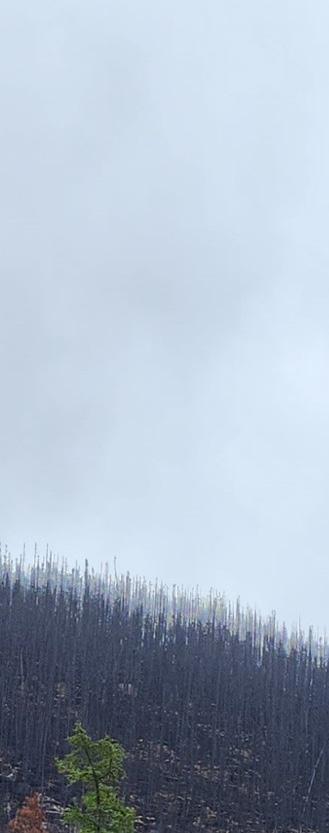

In 2023, BGC collaborated with universities on projects and initiatives aligned with our corporate goals; partnering with graduate-level research programs in Canada and abroad. Through our sponsorship of research chairs and programs, we have directed lines of investigation toward important challenges facing our society, advanced the state of the art in our field, and helped inspire the next generation of geoprofessionals. This ongoing involvement with academia has undoubtedly attributed to the number of BGC staff seeking graduate opportunities and attracting new staff passionate about academic research.
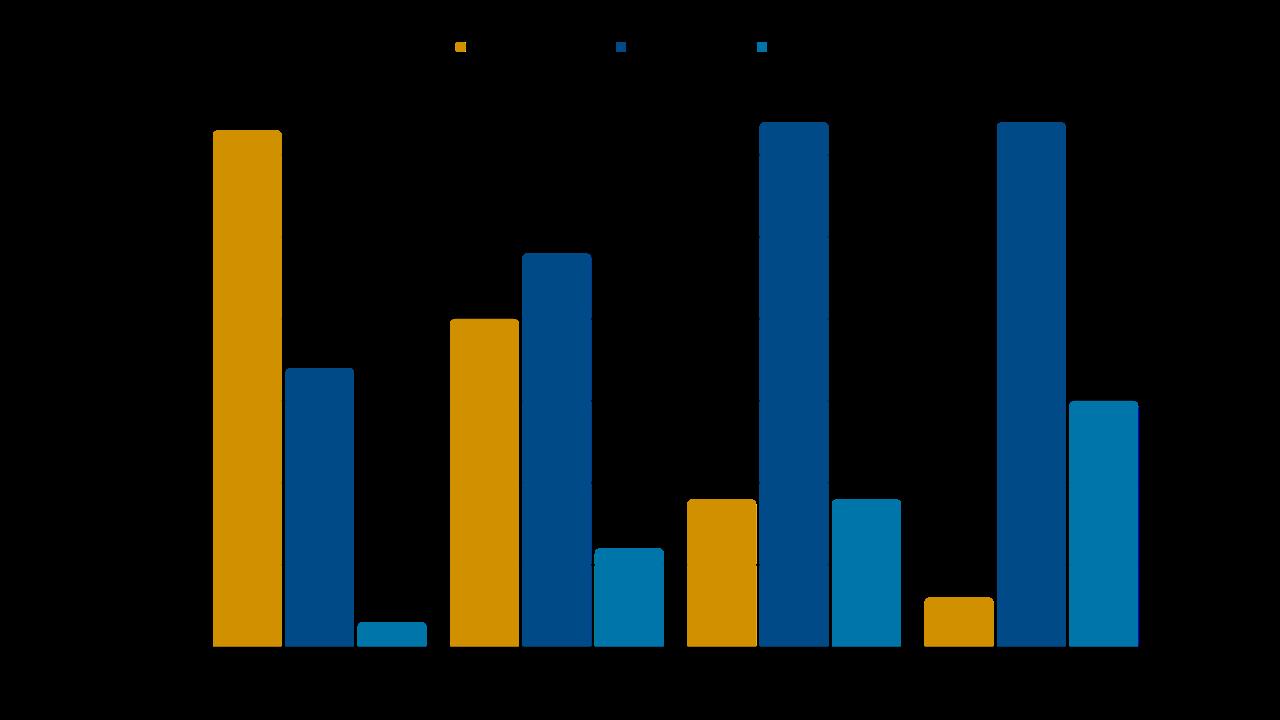
BGC has continued to invest in collaborative research through funding support and direct participation in field- and lab-based studies. Examples of continued support for University programs include, Katherine Johnston, M.Sc., P.Eng., P.Geo., and Matt Lato, Ph.D., P.Eng. are on the curriculum advisory boards at UBC and Queen’s in support of their Geological Engineering Programs and Caroline Bates, M.A.Sc., P.Eng. is a member of the Advisory Board for FRBC Endowed Chair in Resource Geoscience and Geotechnics, held by Sergio Sepulveda, Ph.D. at Simon Fraser University. In 2023, BGC collaborated with 20 universities, including Colorado School of Mines, Dalhousie University, Durham University, Queen’s University, University of Alberta, University of British Columbia, and University of Calgary.
Gemma Bullard , Ph.D., P.Eng. University Connections Research & Development Lead

Underground Trenchless Construction
University: University of Alberta
BGC Team: Jeremy Groves, M.A.Sc., P.Eng; Pete Barlow, M.Sc., P.Eng.
Remote Sensing Data to Assess Shoreline Erosion for the Site C Project
University: University of British Columbia (UBC)
BGC Team: Beatrice Collier-Pandya, M.A.Sc., P.Eng.
Biocementation of Mine Tailings
University: University of British Columbia (UBC)
BGC Team: Bill Burton, M.Eng., P.Eng.; Julian McGreevy, B.A.Sc., P.Eng.
Experimental and Numerical Experiments Related to River
Width and Effect on Bedload Transport and Morphology
University: University of British Columbia (UBC), University of Waterloo
BGC Team: Rob Millar, Ph.D., P.Eng., P.Geo.
Boulder Seeding Pilot Project on the Coquihalla River
University: University of British Columbia (UBC)
BGC Team: Sarah Davidson, Ph.D., P.Geo
Nicola River Geomorphic Change
University: University of British Columbia (UBC)
BGC Team: Sarah Davidson, Ph.D., P.Geo
UAV Lidar Drone
University: University of British Columbia (UBC)
BGC Team: Andrew Mitchell, Ph.D., P.Eng
Mining Microbiome Analysis Platform (MMAP)
University: University of British Columbia (UBC)
BGC Team: Bill Burton, M.Eng., P.Eng.; Julian McGreevy, B.A.Sc., P.Eng.
Mentorship with Graduate Students
University: University of British Columbia (UBC)
BGC Team: Lucy MacKenzie, Ph.D.
Committee Support for Graduate Students
University: University of British Columbia (UBC)
BGC Team: Sarah Davidson, Ph.D., P.Geo
CanBreach - Tailings Dam Breach Analysis
University: University of British Columbia (UBC), Queen’s Univeristy, University of Waterloo
BGC Team: Angela Kupper, Ph.D., P.Eng., FEIC; Andrea Walsh, M.A.Sc., P.Eng.; Brad Russell, M.Sc., P.Eng.; Cindy Wang, B.A.Sc., P.Eng.; Daley Clohan, P.Eng., PMP; Ed Carey, P.Eng.; Gemma
Bullard, Ph.D., P.Eng.; Hillary Topps, B.Eng., P.Eng.; Kayleigh
Barlow, M.A.Sc., EIT; Patrick Grover, Ph.D., P.Eng., CSPO
Tailings Dam Breach Detection Monitoring with Fibre Optics and Seismic Sensors
University: University of Calgary
BGC Team: Angela Kupper, Ph.D., P.Eng.; Matt Lato, Ph.D., P.Eng.; Saman Zarnani, Ph.D., P.Eng.; Susanne Ouellet, Ph.D. Candidate, P.Eng.
Hazards Arising from Permafrost Thaw
University: University of Calgary
BGC Team: Lukas Arenson, Ph.D., P.Eng.
Practical Applications of Anisotropic and Distributed Rock Mass Strengths in Slope Stability Analyses
University: Dalhousie University
BGC Team: Derek Kinakin, M.Sc., P.Geo., P.L.Eng., CPG
Tailings Dam Likelihood and ALARP Pilot Project
University: University of Delft
BGC Team: Brad Russell, M.Sc., P.Eng.; John Whittall, M.A.Sc., P.Eng.
Permafrost and Geophysics Research to Support Water Balance Modelling
University: University of Fribourg
BGC Team: Cassandra Koenig, Ph.D. Candidate, P.Geo.; Lukas Arenson, Ph.D., P.Eng.; Pablo Wainstein, Ph.D., P.Eng.
Nature-based Solutions for Permafrost Stabilization and Permafrost Carbon Fixation Based Solutions
University: Polytechnique Montreal
BGC Team: Lukas Arenson, Ph.D., P.Eng
Systems-level Geohazard Risk Assessment in Southwestern British Columbia
University: Queen’s University
BGC Team: Jack Park, M.A.Sc. Candidate, P.Eng.; Kris Holm M.Sc., P.Geo.
Geological Model of the Surficial Geology of the Red Chris Project Area
University: Simon Fraser University
BGC Team: Daryl Dufault, B.A.Sc., P.Eng.; Madeleine Sauve, M.Sc. Candidate, P.Eng.
Satellite InSAR Research Collaboration
University: University of Waterloo
BGC Team: Evan Deane, M.Sc., EIT; Jeanine Engelbrecht, Ph.D.
Triaxial Scale Effects Testing
University: University of Western Australia
BGC Team: Adrian Wightman, M.Sc., P.Eng., FEIC; ChangGyun Jeong, M.Sc., P.Eng.; Mike Billings, B.Sc.E., P.Eng.; Simon Dickinson, Ph.D., P.Eng.; Wesley Tibbet, M.Eng., P.Eng.
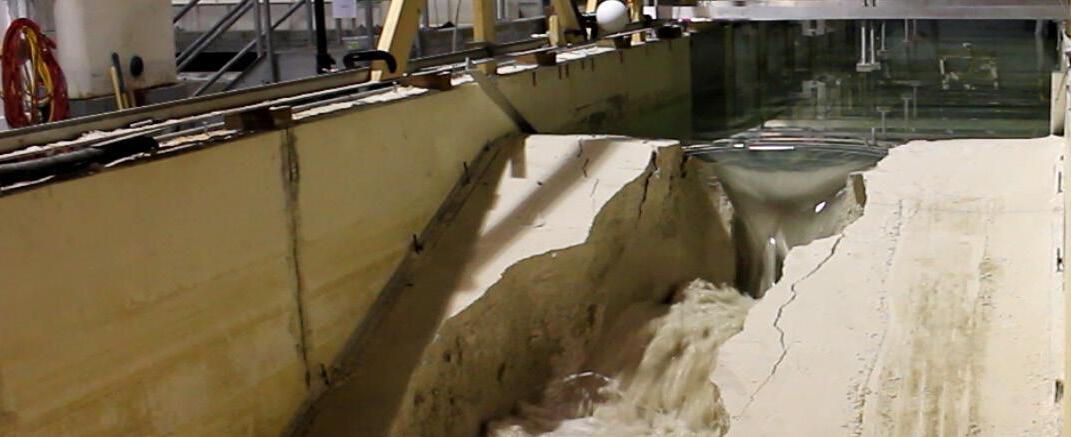

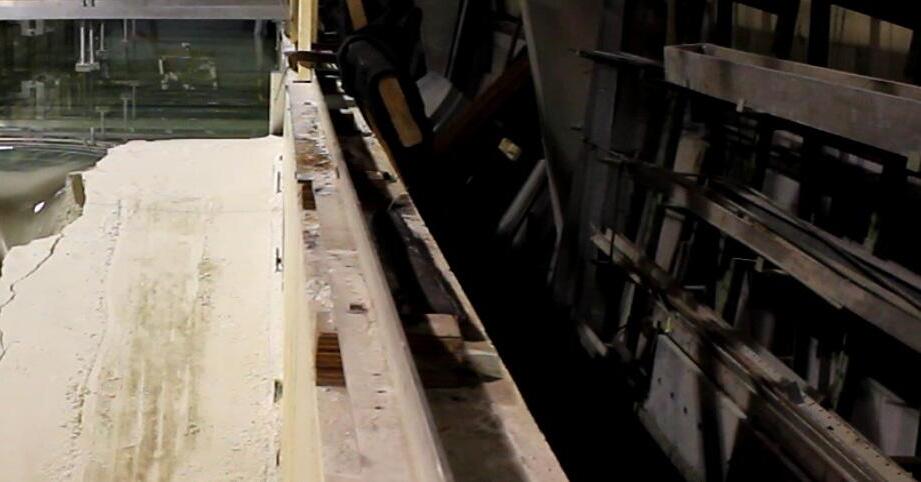
In 2023, BGC continued to support the CanBreach project which was launched in 2019. CanBreach is an NSERC-funded universityindustry project with a research team including three Canadian universities (UBC, Queen’s and Waterloo), two large mining companies (Imperial Oil Ltd. and Suncor), and three industry-leading consulting companies (BGC, Klohn Crippen Berger and WSP Global Inc.). The diversity of the research team allows an integrated approach to research that positions Canadian companies at the forefront of tailings dam engineering and, ultimately, improves the safety and sustainability of mining operations in Canada and worldwide.
The two central goals of the CanBreach project are to 1) significantly improve our understanding of tailings dam breach and runout processes and characteristics and 2) develop improved dam breach and runout analysis methods that increase the credibility of tailings dam breach inundation maps, dam consequence classifications, and emergency preparedness and response plans. The CanBreach program is just wrapping up its first 4-year term and is preparing for a second 4-year term starting in September 2024.
The CanBreach Team has published seven journal articles and 12 conference papers to date. BGC has hired three graduates of the CanBreach Team from Queen’s University: Andrea Walsh, M.A.Sc., P.Eng., Kayleigh Barlow, M.A.Sc., EIT, and Meg McKellar, M.A.Sc.
Several BGC staff serve as adjunct professors and sessional lecturers at universities and colleges across North America:
Brett Eaton, Ph.D., P.Geo.: University of British Columbia (Professor Emeritus)
Carl Mendoza, Ph.D., P.Eng., P.Geo.: Simon Fraser University; University of Alberta (Professor Emeritus)
Chris Pederson, M.Sc., PE: Colorado School of Mines
Dave Gauthier, Ph.D., P.Eng., P.Geo.: Queen’s University; Lakehead University
Ethan Faber, M.Sc., PE: Colorado School of Mines
Lukas Arenson, Ph.D., P.Eng.: University of Manitoba; Polytechnique Montreal
Marc-Andre Brideau, Ph.D., P.Geo.: Simon Fraser University
Matt Lato, Ph.D., P.Geo.: Queen’s University; Colorado School of Mines (Affiliate Professor)
Sarah Davidson, Ph.D., P.Geo.: University of British Columbia
Willy Zawadzki, M.Sc., P.Geo.: University of British Columbia
These BGC staff, along with other senior BGC personnel, act as primary, secondary, or external co-supervisors and advisors on various masters and doctorate-level theses. In 2023, many of our staff also presented guest lectures across Canada, the US, South America, and Europe. To further strengthen our collaboration with international institutions, meetings were held with geoscience and engineering staff at universities, notably the University of California, Berkeley.
Over the past 12 months, BGC staff produced 102 research publications and presentations with wide-ranging applications for the mining, pipelines, transportation, and communities sectors. More than 115 staff members contributed to at least one publication over the past year, collaborating with colleagues in and outside the company to advance knowledge in applied earth sciences. Research topics reflect our team’s diverse expertise and interests, including earthquake engineering, geohazards, cold regions engineering, augmented reality, foundations engineering, groundwater, hydrology, tailings dam engineering, geophysics, remote sensing, climate change, soil and rock mechanics, and mine closure.
BGC staff published 24 articles within journals such as Nature Communications, Bulletin of the Seismological Society of America, Earth Surface Processes and Landforms, Frontiers in Earth Science, Hydrological Processes, Landslides, and Soil Dynamics and Earthquake Engineering. The Seismic Record’s July issue featured BGCer Jamey Turner’s article on the Hosgri fault as its lead article.
Staff also presented research at 36 conferences, sharing over 75 papers and talks at industry events across North America, South America, Europe, Asia, and Australia:
At the 1st GeoMandu conference in Kathmandu, Nepal, Lukas Arenson, P.Eng. delivered a keynote address and Hamish Weatherly, M.Sc., P.Geo. presented his work as an invited speaker.
Dan Costello, M.Sc., P.Geo. and Martin Zaleski, M.Sc., P.Geo. were awarded the NASTT 2023 Outstanding Paper – New Installation award at the North American Society for Trenchless Technology conference.
Kate Robey, M.Sc., Pr.Sci.Nat. received the 2nd Best Oral Presentation Award at the IAH Worldwide Groundwater Congress held in Cape Town, South Africa.
BGC published 102 papers in 202378 were presented at 36 different conferences on 5 continents
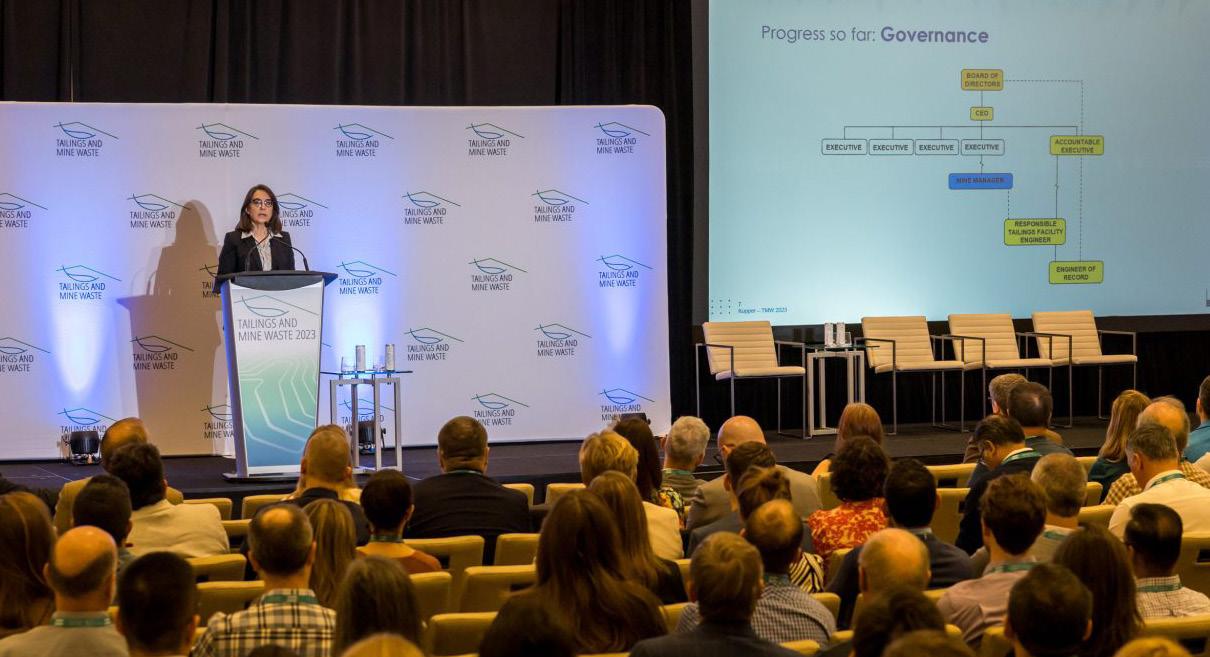

Asian Regional Conference on Soil Mechanics and Geotechnical Engineering
Association of Environmental & Engineering Geologists Annual Meeting
Canadian Geotechnical Conference
Canadian-Pacific Conference on Earthquake Engineering
Canadian Remote Sensing Symposium
Canadian Water Resources Association National Conference
Deep Foundations Conference
Environmental and Engineering Geophysical Society and Association of Environmental & Engineering Geologists Symposium
European Conference on Permafrost
European Geosciences Union General Assembly
GeoConvention
Geological Society of America Annual Meeting
GeoMandu: Geohazards and Geo-Infra Disasters Conference
Global Space Conference on Climate Change
Gravel Bed Rivers Conference
Highway Geology Symposium
Indian Geotechnical Conference
International Commission on Large Dams (ICOLD) Annual Meeting
Journals
Applied Ocean Research
Bulletin of the Seismological Society of America
Communications Earth & Environment
Deep Foundations
Earth Surface Processes and Landforms
Environmental Geotechnics
Frontiers in Earth Science
Geosciences
Geosynthetics International
Geotechnical and Geological Engineering
Heritage
International Conference on Debris Flow Hazard Mitigation
International Conference on Fluvial Hydraulics
International Conference on Geosynthetics
International Conference on Grouting and Deep Mixing
International Conference on Mine Closure
International Conference on Scour and Erosion
International Conference on Tailings Management
International Slope Stability Symposium
Joint Technical Committee on Natural Slopes and Landslides (JTC1) Workshop
Jornadas Impacto del Cambio Climático en Infraestructura
Vial
Maintenance, Engineering and Reliability/Mine Operators Conference
No-Dig Down Under Conference
North American Society for Trenchless Technology No-Dig Show
Pipeline Pigging and Integrity Management Conference
River, Coastal, and Estuarine Morphodynamic Symposium
Summit on Drone Geophysics
Tailings and Mine Waste Conference
Worldwide Groundwater Congress
Hydrological Processes
ISPRS International Journal of Geo-Information
Journal of Hydrology: Regional Studies
Journal of Multivariate Analysis
Landslides
Natural Hazards
Nature Communications
Polar Science
Remote Sensing
The Seismic Record
Soil Dynamics and Earthquake Engineering
Waste Management
On September 21st 2023, BGC hosted its first-ever online R&D symposium. Eleven BGCers across a variety of sectors and disciplines as well as five external researchers/Ph.D. students presented their work in this four-hour online event. The following are a few statistics about the event:
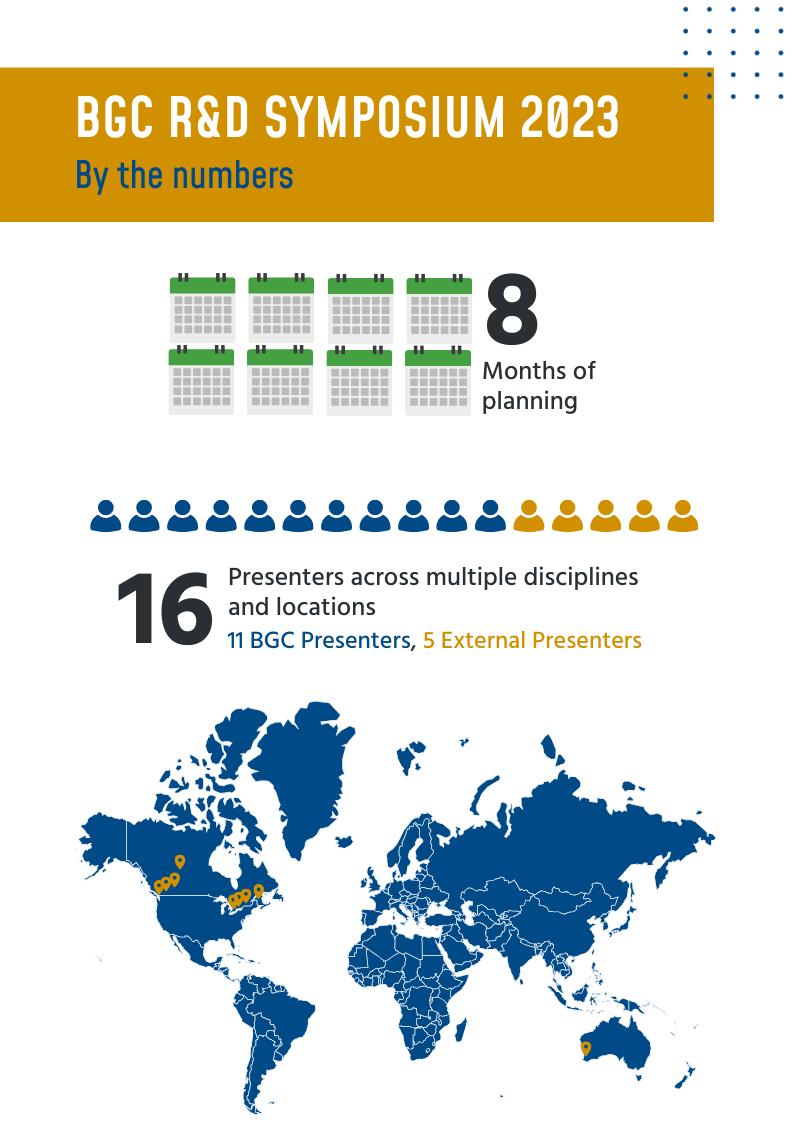


 Vicky Hsiao, M.A., M.Sc., and Alex Graham’s, GIS AdvDip., M.Sc., presentation on Lidar Change Detection.
Vicky Hsiao, M.A., M.Sc., and Alex Graham’s, GIS AdvDip., M.Sc., presentation on Lidar Change Detection.
